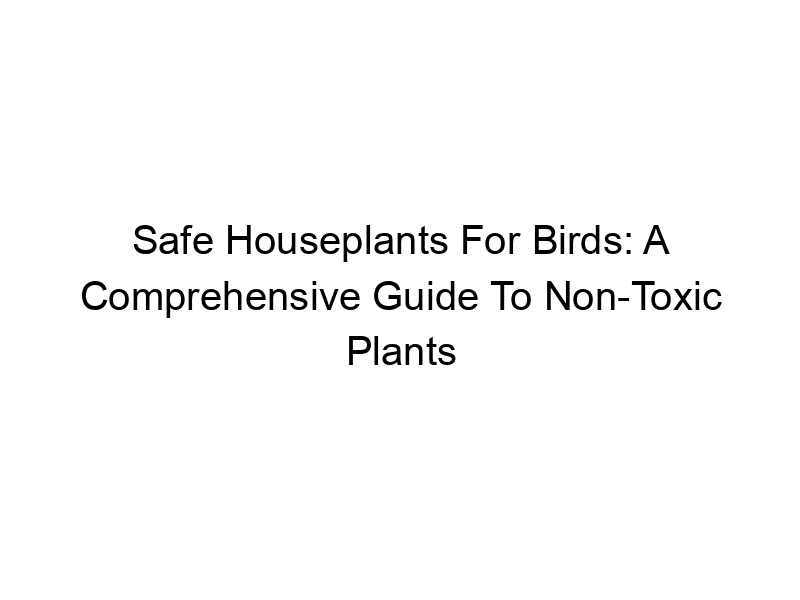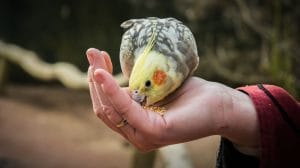Sharing your home with feathered friends brings immense joy, but it also requires careful consideration of their safety. Many common houseplants are toxic to birds, posing serious health risks. This guide explores the crucial topic of Bird-Friendly Houseplants: Safe and Toxic Plants for Pet Birds, helping you create a beautiful and safe environment for your beloved avian companions. We’ll delve into identifying safe plants, understanding the dangers of toxic plants, and creating a thriving indoor garden that’s both aesthetically pleasing and bird-safe. You’ll learn how to identify potentially hazardous foliage, discover a selection of bird-safe plants, and learn how to prevent accidental ingestion.
Many plants contain toxins that can cause various health problems in birds, ranging from mild digestive upset to severe organ damage and even death.
These toxins, often secondary metabolites produced by the plants for defense mechanisms, can interfere with vital bodily functions. The sensitivity of birds to these toxins varies depending on the species of both bird and plant, as well as the quantity ingested.
Common symptoms of plant poisoning in birds
Symptoms of plant poisoning can manifest differently depending on the specific toxin and the amount consumed. However, common signs include lethargy, vomiting, diarrhea, difficulty breathing, tremors, seizures, and loss of coordination. If you suspect your bird has ingested a toxic plant, immediate veterinary attention is crucial.
Identifying Potentially Harmful Houseplants
Commonly Toxic Houseplants
Many popular houseplants pose significant risks to birds. These include Dieffenbachia (Dumb Cane), Pothos (Devil’s Ivy), Philodendron, Sago Palm, Azaleas, Tulips, and many more. Even a small amount of ingested leaf or stem can trigger adverse reactions. It’s crucial to thoroughly research any plant before introducing it into your home if you have birds.
Understanding Toxicity Levels
The toxicity levels of plants vary widely. Some plants may cause minor irritation, while others can be life-threatening. Online resources and veterinary professionals can provide information on toxicity levels, but it’s always best to err on the side of caution and avoid potentially harmful plants altogether.
Choosing Bird-Safe Houseplants
Safe Plants for Your Avian Companions
Fortunately, there’s a wide selection of beautiful and safe houseplants suitable for homes with birds. These include African Violets, Spider Plants, Boston Ferns, Peperomia, Calathea, and many more. These plants offer a variety of textures, colors, and sizes, allowing you to create a vibrant and safe indoor garden.
Researching Plant Safety Before Purchase
Before bringing any new plant into your home, always research its safety for birds. Numerous online databases and resources list both toxic and non-toxic plants. Checking multiple sources is recommended to ensure accuracy. When in doubt, always choose a known safe plant.
Creating a Bird-Safe Indoor Garden
Placement of Plants
Even safe plants can present a risk if placed within reach of your birds. Consider placing plants on high shelves, hanging baskets, or in areas inaccessible to your feathered friends. This minimizes the risk of accidental ingestion or damage to the plants themselves.
Plant Maintenance and Care
Proper plant care is essential for maintaining a healthy and safe indoor environment. Regular watering, fertilizing, and pruning will keep your plants thriving and minimize the chance of pests or diseases, which could further endanger your birds.
Benefits of Bird-Safe Houseplants
Enhancing the Home Environment
Bird-safe houseplants add beauty and life to your home while ensuring the safety of your avian companions. The greenery can create a calming and enriching environment for both you and your birds.
Air Purification
Many houseplants, including several bird-safe options, help purify the air by absorbing toxins and releasing oxygen. This can contribute to a healthier environment for both you and your pets.
Further Considerations for Bird Owners
Other Potential Hazards in the Home
Besides plants, other household items can pose risks to birds. These include cleaning products, certain cooking utensils, and even some types of fabrics. It’s important to bird-proof your entire home to minimize potential dangers.
Consult with Avian Veterinarians
If you have any concerns about the safety of your plants or have a bird that has shown symptoms of illness, consult an avian veterinarian immediately. They can provide expert advice and treatment.
Types of Bird-Safe Plants: A Detailed Overview
African Violets (Saintpaulia ionantha)
These compact, flowering plants are not only beautiful but also safe for birds. Their soft, velvety leaves add a touch of elegance to any room.
Spider Plants (Chlorophytum comosum)
Spider plants are easy to care for and produce “spiderettes,” or baby plants, which can be propagated to create more plants.
Boston Ferns (Nephrolepis exaltata)
These lush, cascading ferns add a touch of the outdoors to any indoor space and are non-toxic to birds.
Comparing Safe and Toxic Plants
Toxicity Chart: Key Differences
(A table comparing several common houseplants – both safe and toxic – with their toxicity levels for birds could be included here. The table should include the plant name, toxicity level (e.g., mild, moderate, severe), and any common symptoms of ingestion.)
Visual Identification: Tips and Tricks
Learning to visually identify common toxic houseplants can be invaluable. This involves familiarizing yourself with the appearance of leaves, flowers, and stems. Many online resources provide visual guides.
Maintaining a Bird-Friendly Home
Simple Steps to a Safer Environment
Creating a bird-friendly home involves careful planning and proactive measures. This includes thoroughly researching any plants before purchase, placing plants out of reach of your birds, and being vigilant about potential hazards.
Ongoing Monitoring and Prevention
Regular monitoring of your birds and their environment is crucial. Observe their behavior for any signs of illness or distress. Regular cleaning and tidying up can also prevent accidents.
Frequently Asked Questions
What are the most common symptoms of plant poisoning in birds?
Common symptoms include lethargy, vomiting, diarrhea, difficulty breathing, tremors, seizures, and loss of coordination. The severity depends on the plant and amount ingested.
Are all ferns safe for birds?
While many ferns are safe, it’s always best to specifically identify the type of fern before introducing it to your bird’s environment. Some ferns may have mild toxicity.
How can I prevent my bird from accessing toxic plants?
Place plants out of reach, use hanging baskets, or place plants in rooms your bird doesn’t access.
What should I do if my bird ingests a toxic plant?
Contact an avian veterinarian immediately. Time is critical in treating plant poisoning in birds.
Are there any resources available to identify toxic plants?
Yes, several online databases and pet safety websites provide comprehensive lists of toxic and non-toxic plants for birds.
Can I use pesticides around my bird-safe plants?
Avoid using pesticides near bird-safe plants. Many pesticides are toxic to birds, even those designed for indoor use.
Final Thoughts
Creating a bird-friendly home that is both beautiful and safe is achievable with careful planning and attention to detail. By understanding the dangers of toxic plants and choosing bird-safe alternatives, you can provide a healthy and enriching environment for your feathered companions. Remember to thoroughly research any new plants before bringing them into your home and always consult with an avian veterinarian if you have any concerns. Creating a safe and beautiful home for your birds is an investment in their well-being and longevity. Take the time to research and choose wisely; your birds will thank you for it! Start creating your bird-friendly oasis today!




